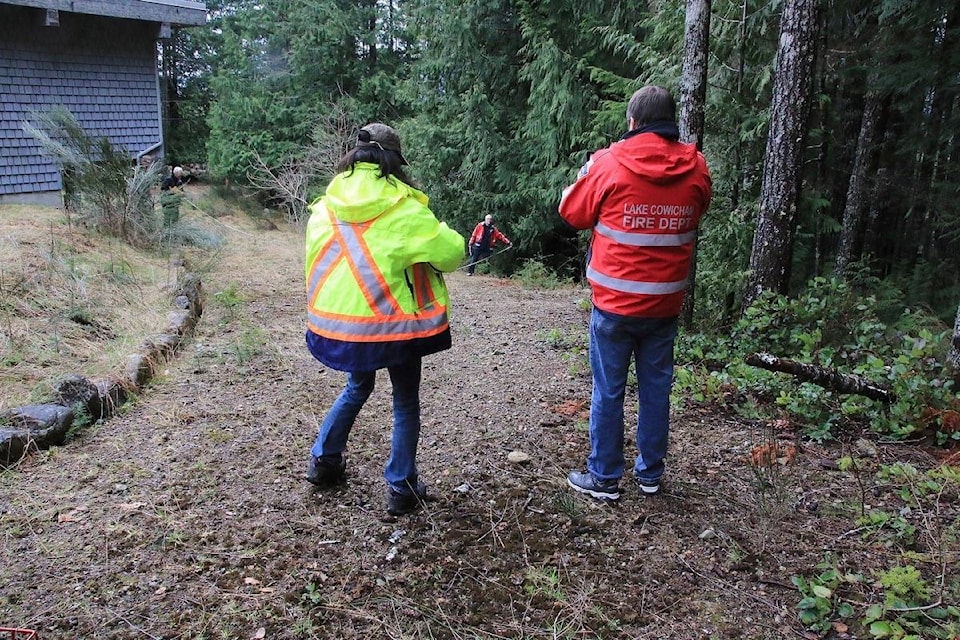We’ve all heard about fire safety in the home, but what about outside your house?
The Lake Cowichan Fire Department is kicking off a program called FireSmart, with a special information day at the fire hall on North Shore Road Saturday, May 6 from 10 a.m. to 2 p.m.
According to The Homeowners FireSmart Manual, published by the B.C. government, the “rural reality” is that “wildfires are capable to spreading at an astonishing rate. Crowning forest fires are often spread at up to 5.5 km per hour, with spotting as far as two kilometres ahead. Wind-blown grass fires can spread at speeds up to 8.5 km per hour.”
If you live in or near a forested region, sooner or later you may have to contend with the spread of a wildfire, firefighters say, adding the best protection is prevention.
FireSmart is all about safeguarding your home from forest fires by paying close attention to what firefighters call the “interface” area around your house, particularly if you live adjacent to forest land.
They’re hoping to be able to inspire neighbourhood groups to join together to look carefully around and see where problems might be waiting in and around or near their houses.
The FireSmart idea is to consider three priority zones around your house.
Priority Zone 1 covers the first 10 metres out from the building, which firefighters say should be a fire-resistant zone, free of all materials that could ignite from a wildfire.
Zone 2 includes from 10-30 metres out from the house. Here, homeowners need to look at reducing fuels for wildfires by thinning and pruning vegetation and trees.
Zone 3 covers from 30-100 metres away from your home and thinning vegetation there can help reduce both the spread and intensity of wildfires.
You can do your own site assessment by looking at a few questions and carefully considering the answers. For instance, what kind of roofing do you have? Asphalt shingles, metal or clay tile are better than untreated wooden shakes. And, how clean is that roof? You can do something about clogged gutters or extensive leaf litter quite inexpensively.
Another relatively inexpensive way to safeguard your house is to ensure that eaves and vents are closed up and screened with fine mesh.
When looking at the house itself, fire safety is better in a home with a non-combustible exterior, like stucco, metal siding or brick. Wood, vinyl siding or wood shakes are more likely to catch fire.
How about considering screening in your porch or deck? If unscreened or screened with combustible material, these areas can be vulnerable to the sparks and bits of blowing debris that firefighters know as “firebrands” and which can get caught in these open areas and ignite your house.
Another favourite place for firebrands to land is your woodpile. Where is it located? If it’s up against the house or in the open area under the sundeck, it’s not a hard fix to move it more than 10 metres away. Other places to look around your home include outside the garage: it’s not uncommon for unused pieces of lumber to end up there or old propane tanks. Take a look.
Gardeners who’ve planted trees near the house should consider removing them, especially coniferous trees, which ignite quickly.
If you’re on rural land, make sure your driveway is clear of trees and is accessible by emergency vehicles.
The author had a visit recently from Lake Cowichan fire chief Doug Knott; the department’s risk management officer, Steve Vatcher; and Margaret Simon of Stratchona Forestry Consulting.
As Knott considered the property a good example of “interface” land, the trio did an assessment to get its FireSmart rating.
The result was eye-opening.
While giving the nod to a lack of plantings near the house, an asphalt shingle roof, and a concrete apron right up to the back door, Simon, Vatcher, and Knott were not thrilled about finding wooden shingles on the side of the house, a lack of mesh in the vents, or even obscured house numbers. Everybody’s property will get a different rating but just looking around with the list in your hand can be a learning experience.
Making the effort to get together to eventually have a FireSmart neighbourhood, with its own sign, or even a FireSmart community, could also save everybody money in the future, Knott said, explaining that there’s a possibility that insurance companies may react favourably to areas that show they are less vulnerable to fire.
In addition, knowing ahead of time which areas are more likely to survive a wildfire will assist firefighters in parcelling out limited resources if there is a forest fire in the area, the fire chief explained.
